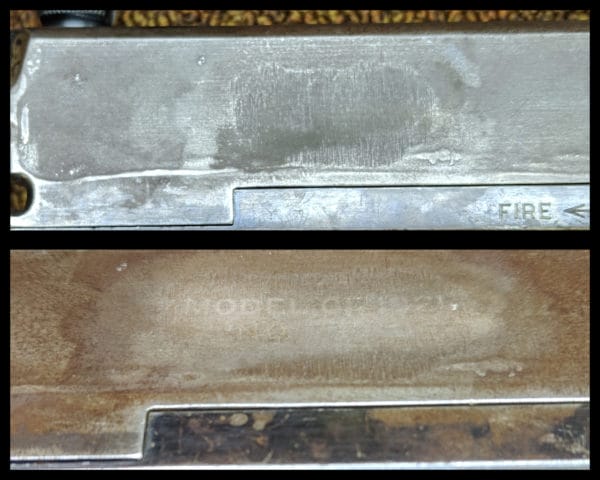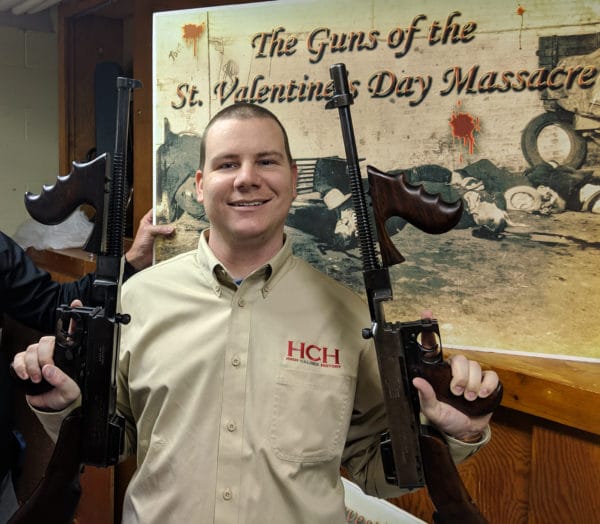Chicago, IL – -(Ammoland.com)- The 1929 St. Valentine’s Day Massacre in Chicago is one of the most well-known crimes of the 20th century. It has it all: Al Capone, Bugs Moran, illegal alcohol, a gang war, and, of course, Tommy guns. What is less-known, however, is the detailed history of the two Tommy guns used in the crime and how they eventually ended up in the Sheriff’s Office in St. Joseph, Michigan.
The video I made at the top of this page details the entire saga. If you’d rather read the story instead, it unfolds here.
On February 14, 1929, a group of men from the South Side Gang were gathered in a garage owned by George “Bugs” Moran. The men were unloading a shipment of liquor when they were surprised by a group of local police. The officers ordered the men to line up against a brick wall, presumably to be searched, cuffed, stuffed into a car, and whisked away to the local police station for booking. Or, if they were lucky, these officers would be on the take and could easily be dispatched with some cash and, perhaps, a case of the illegal hooch.

Instead, the officers turned out to be imposters. They were members of Al Capone’s North Side Gang, sent to take out Moran. These “officers” watched as two other well-dressed men entered the garage, produced an array of weapons, including two Thompson submachine guns, and killed the seven men from Moran’s gang as they stood against the wall. With the deed done, the guns were handed to the “police” and they escorted the shooters outside to a waiting phony police car, acting as if they had arrested the men.
Approximately 70 shots were fired from the two Thompsons in the garage. A couple shotgun blasts rounded out the carnage.
A number of men were suspected of being involved in the crime. Despite numerous eyewitness reports of what happened and rigorous questioning of some suspects, there wasn’t sufficient evidence to bring anyone up on charges.
Fred “Killer” Burke is one of the gangsters who was suspected of being a gunman in the garage. But just like the others, there wasn’t enough evidence to try him for the crime. The case went cold until later that year when Burke shot a cop after a fender-bender and fled the scene. The police searched his home in St. Joseph, Michigan, and two Tommy guns were found as part of the raid.
The Thompsons were turned over to Dr. Calvin Goddard in Chicago, where he was pioneering the fledgling field of forensic ballistics. Goddard was an Army officer and the head of the Bureau of Forensic Ballistics, which was the first independent crime lab in the United States.
Goddard test fired the guns taken from Burke’s home in order to compare them to the bullets and spent cartridges recovered from the scene of the massacre. Using a microscope to examine the rifling marks on the bullets, the firing pin indentations on the primers, and markings on the cartridge from the extractors, Goddard was able to confirm that the Thompson submachine guns found in Burke’s closet were indeed the ones used on February 14, 1929.
It’s important to note, though, that even though the guns were tied to the massacre, neither gun could be tied to a shooter or shooters. As such, Burke was never tried for the crime even though the guns were found in his house.
Thompson submachine gun Model of 1921, serial number 2347, was produced by Colt’s Patent Firearms Co. and delivered to Auto-Ordnance between July 18 and 23, 1921. On November 12, 1924, it was sold to Deputy Sheriff Les Farmer of Marion, Illinois. Farmer left his career in law enforcement to become a member of the St. Louis-based gang known as Egan’s Rats. Serial 2347 eventually found its way into the hands of Fred “Killer” Burke sometime before the St. Valentine’s Day Massacre.

The other Tommy gun tested by Goddard was also made by Colt’s Patent Firearms Co. and was also delivered to Auto-Ordnance on January 30 or 31, 1922, as a Model of 1921A. The barrel was later modified with a Cutt’s Compensator, re-designated as a Model of 1921AC, and was sold to Von Frantzius Sporting Goods in Chicago on October 19, 1928. It was one of three Thompsons in the shipment, each accompanied by a drum magazine.
Mr. Von Frantzius sold the gun to Mr. Frank V. Thompson, who requested arrangements be made by Mr. Von Frantzius to have local gunsmith Valentine Guch remove the serial number, which was 7580, from all parts of the gun. Mr. Guch’s work cost an additional two dollars.
The gun was packed in a crate, along with four bricks, and mailed from the sporting goods store to an address belonging to Victor Thompson in Elgin, Illinois. Victor then gave the gun to Frank on October 23, 1928. Serial 7580 was then sold by Frank to Mr. Bozo Shupe of Chicago, who is believed to have been the man who put it into circulation with the gangsters before the massacre.
Shupe was questioned by authorities in an effort to find out what happened to the gun. He refused to provide any information and was soon found murdered on Chicago’s West Side.
Because Valentine Guch had removed the serial number from the gun, Calvin Goddard had to find a way to recover any trace elements of it. To do this, he poured acid on the gun in order to raise the etching, traces of which were buried deeper in the gunmetal.

Goddard’s acid method worked. The model and serial number were indeed visible, albeit rather faint when viewed at the right angle under ideal lighting conditions. Goddard’s goal was to identify the gun by any means necessary; preserving it for the future was not part of his goal, and so the acid he used ate away at the gun’s finish. Evidence of the acid-induced finish loss is still visible on the gun today.
The two Thompson submachine guns, serial numbers 2347 and 7580, are held at the armory of the Berrien County Sheriff’s Department in St. Joseph, Michigan. The guns are still considered to be evidence in the seven unsolved murders of the St. Valentine’s Day Massacre.
About Logan Metesh
Logan Metesh is a historian with a focus on firearms history and development. He runs High Caliber History LLC and has more than a decade of experience working for the Smithsonian Institution, the National Park Service, and the NRA Museums. His ability to present history and research in an engaging manner has made him a sought after consultant, writer, and museum professional. The ease with which he can recall obscure historical facts and figures makes him very good at Jeopardy!, but exceptionally bad at geometry.


Too Bad he had to use acid to get the serial number. Apparently he did not contact Auto-Ordnance about the guns as they would have told him about the “secret” serial number located under the forward grip mount on the upper receiver/frame which are present on Colt built guns.
During the last three months of my tour in Nam I was assigned a new job, and part of that job included a different weapon as part of the security we had. That weapon was a Thompson. We had to fam fire the weapon as part of training for the job and it was fun. Much more recoil than an M-16, much more. We had one guy who was barely able to pass the height requirement of the Marine Corps and was small of stature. He decided he was going to fire a full magazine non-stop. He wrapped himself around… Read more »
Good article, I was aware of the Valentine’s day massacre but I had never heard the part about the guns.
@Tcat, Most enjoyable, and a couple of lessons in it, too! For example: Don’t leave evidence in your home.
Guns that basically gave us gods gift to gun control nfa34.
But i love thompsons and the 45 acp round.
May hells forever fire roast those responsible for the nfa
Moran was the North Side Gang. Capone was South Side. The North Side Gang effectively went away after 2/14/1929. The South Side Gang continued to flourish through the 1980s and began a decline in the 1990s due to very aggressive law enforcement.